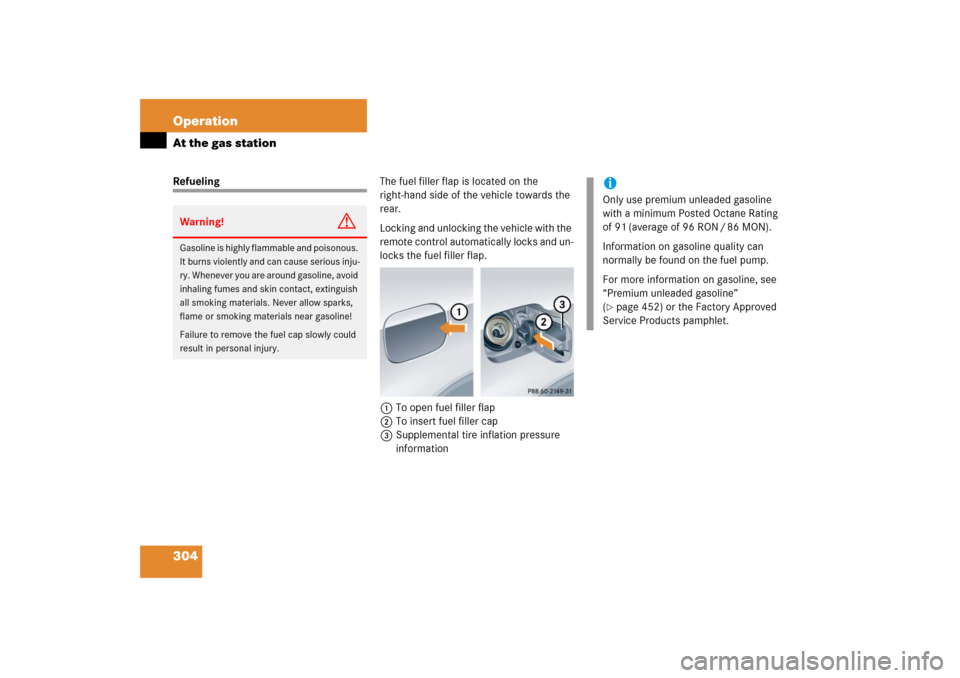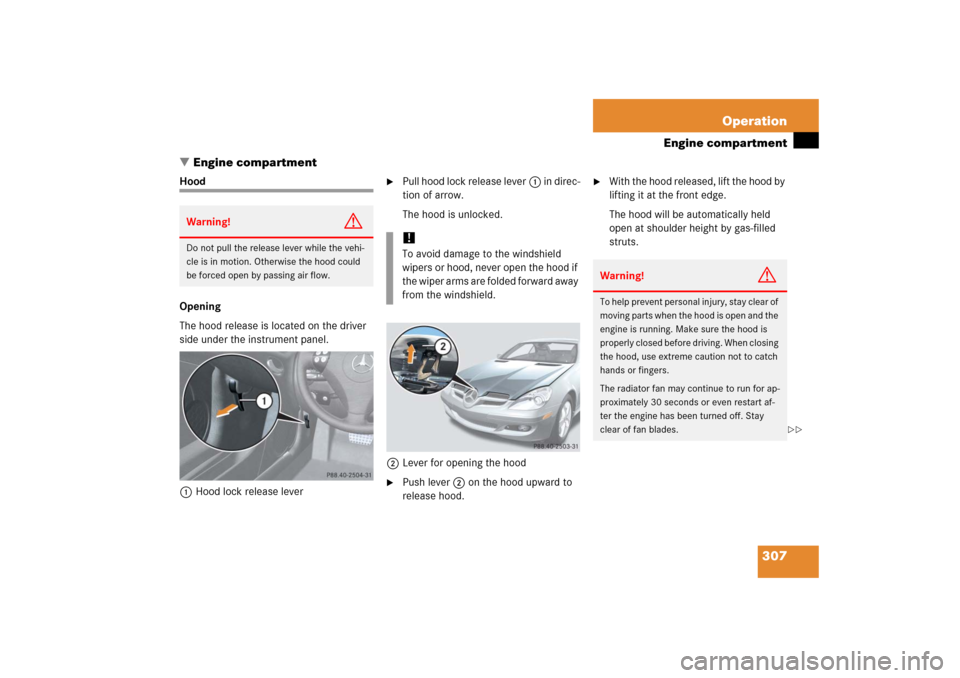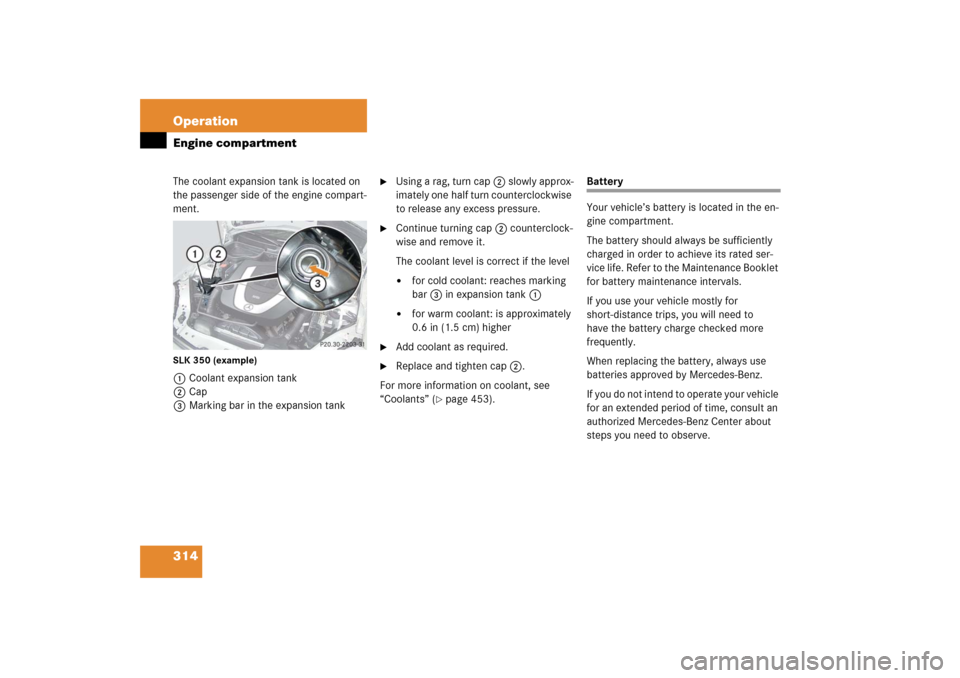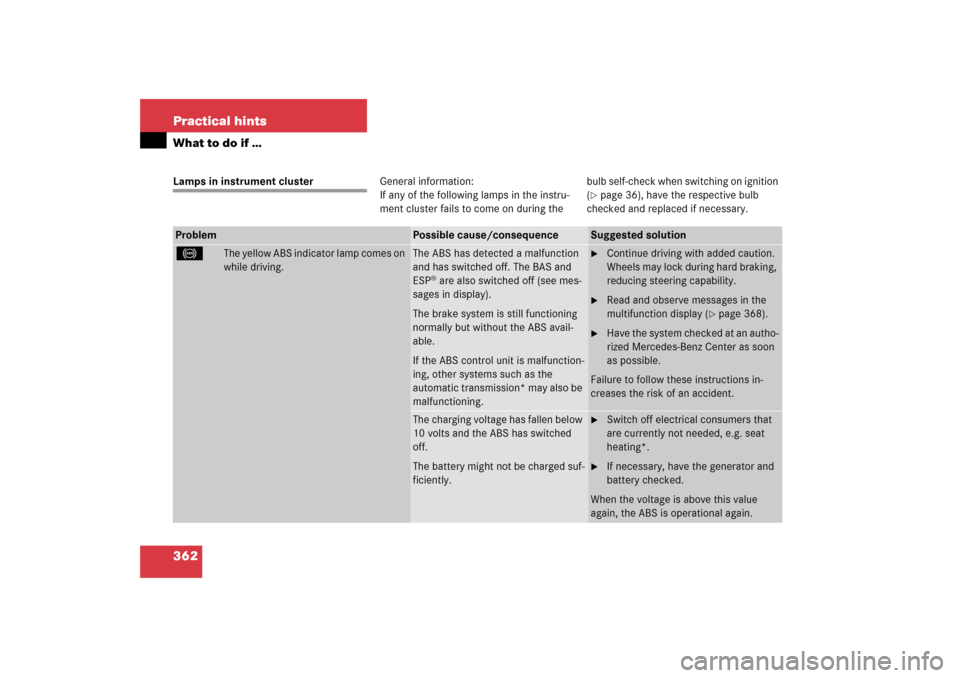Page 305 of 481

304 OperationAt the gas stationRefuelingThe fuel filler flap is located on the
right-hand side of the vehicle towards the
rear.
Locking and unlocking the vehicle with the
remote control automatically locks and un-
locks the fuel filler flap.
1To open fuel filler flap
2To insert fuel filler cap
3Supplemental tire inflation pressure
informationWarning!
G
Gasoline is highly flammable and poisonous.
It burns violently and can cause serious inju-
ry. Whenever you are around gasoline, avoid
inhaling fumes and skin contact, extinguish
all smoking materials. Never allow sparks,
flame or smoking materials near gasoline!
Failure to remove the fuel cap slowly could
result in personal injury.
iOnly use premium unleaded gasoline
with a minimum Posted Octane Rating
of 91 (average of 96 RON / 86 MON).
Information on gasoline quality can
normally be found on the fuel pump.
For more information on gasoline, see
“Premium unleaded gasoline”
(�page 452) or the Factory Approved
Service Products pamphlet.
Page 306 of 481

305 Operation
At the gas station
�
Remove the SmartKey from the starter
switch.
�
Open fuel filler flap by pushing at point
indicated by arrow1.
The fuel filler flap springs open.
�
Turn fuel filler cap counterclockwise
and hold on to it until possible pressure
is released.
�
Take off fuel filler cap and set it in di-
rection of arrow2 in the recess on the
inside of fuel filler flap.
To prevent fuel vapors from escaping
into open air, fully insert filler nozzle
unit.
�
Only fill your tank until the filler nozzle
unit cuts out – do not top up or over-
fill.
�
Replace the fuel filler cap by turning it
clockwise until it audibly engages.
�
Close the fuel filler flap.
Check regularly and before a long tripEngine compartment (SLK 350, example)1Windshield washer system and head-
lamp cleaning system* reservoir
2Brake fluid reservoir
3Coolant expansion tank
Warning!
G
Overfilling of the fuel tank may create pres-
sure in the system which could cause a gas
discharge. This could cause the gas to spray
back out when removing the fuel pump noz-
zle, which could cause personal injury.iLeaving the engine running and the fuel
cap open can cause the yellow fuel
tank reserve warning lamp to flash and
the ?malfunction indicator lamp
(USA only) or the ±malfunction in-
dicator lamp (Canada only) to illumi-
nate.
For more information, see “Practical
hints” (
�page 364).
iFor opening the hood, see “Hood”
(�page 307).
Page 308 of 481

307 Operation
Engine compartment
�Engine compartment
Hood
Opening
The hood release is located on the driver
side under the instrument panel.
1Hood lock release lever
�
Pull hood lock release lever1 in direc-
tion of arrow.
The hood is unlocked.
2Lever for opening the hood
�
Push lever2 on the hood upward to
release hood.
�
With the hood released, lift the hood by
lifting it at the front edge.
The hood will be automatically held
open at shoulder height by gas-filled
struts.
Warning!
G
Do not pull the release lever while the vehi-
cle is in motion. Otherwise the hood could
be forced open by passing air flow.
!To avoid damage to the windshield
wipers or hood, never open the hood if
the wiper arms are folded forward away
from the windshield.
Warning!
G
To help prevent personal injury, stay clear of
moving parts when the hood is open and the
engine is running. Make sure the hood is
properly closed before driving. When closing
the hood, use extreme caution not to catch
hands or fingers.
The radiator fan may continue to run for ap-
proximately 30 seconds or even restart af-
ter the engine has been turned off. Stay
clear of fan blades.
��
Page 309 of 481

308 OperationEngine compartment
Closing�
Let the hood drop from a height of
approximately 1 ft (30 cm).
The hood will lock audibly.
�
Check to make sure the hood is fully
closed.
If you can raise the hood at a point
above the headlamps, then it is not
properly closed. Open it again and let it
drop with somewhat greater force.
Engine oil
The amount of oil your engine needs will
depend on a number of factors, including
driving style. Higher oil consumption can
occur when�
the vehicle is new
�
the vehicle is driven frequently at
higher engine speeds
Engine oil consumption checks should only
be made after the vehicle break-in period.
Warning!
G
If you see flames or smoke coming from the
engine compartment, or if the coolant tem-
perature display in the multifunction display
indicates that the engine is overheated, do
not open the hood. Move away from vehicle
and do not open the hood until the engine
has cooled down. If necessary, call the fire
department.Warning!
G
The engine is equipped with a transistorized
ignition system. Because of the high voltage
it is dangerous to touch any components
(ignition coils, spark plug sockets, diagnos-
tic socket) of the ignition system�
with the engine running
�
while starting the engine
�
if ignition is “on” and the engine is
turned manually
Warning!
G
Be careful that you do not close the hood on
anyone.
iDo not use any special lubricant addi-
tives, as these may damage the drive
assemblies. Using special additives not
approved by Mercedes-Benz may
cause damage not covered by the
Mercedes-Benz Limited Warranty.
More information on this subject is
available at any authorized
Mercedes-Benz Center.
��
Page 315 of 481

314 OperationEngine compartmentThe coolant expansion tank is located on
the passenger side of the engine compart-
ment.SLK 350 (example)1Coolant expansion tank
2Cap
3Marking bar in the expansion tank
�
Using a rag, turn cap2 slowly approx-
imately one half turn counterclockwise
to release any excess pressure.
�
Continue turning cap2 counterclock-
wise and remove it.
The coolant level is correct if the level �
for cold coolant: reaches marking
bar3 in expansion tank1
�
for warm coolant: is approximately
0.6 in (1.5 cm) higher
�
Add coolant as required.
�
Replace and tighten cap2.
For more information on coolant, see
“Coolants” (
�page 453).
Battery
Your vehicle’s battery is located in the en-
gine compartment.
The battery should always be sufficiently
charged in order to achieve its rated ser-
vice life. Refer to the Maintenance Booklet
for battery maintenance intervals.
If you use your vehicle mostly for
short-distance trips, you will need to
have the battery charge checked more
frequently.
When replacing the battery, always use
batteries approved by Mercedes-Benz.
If you do not intend to operate your vehicle
for an extended period of time, consult an
authorized Mercedes-Benz Center about
steps you need to observe.
Page 354 of 481

353 Operation
Vehicle care
�Vehicle care
Cleaning and care of vehicle
While in operation, even while parked, your
vehicle is subjected to varying external in-
fluences which, if gone unchecked, can at-
tack the paintwork as well as the
undercarriage and cause lasting damage.Such damage is caused not only by ex-
treme and varying climatic conditions, but
also by:
�
Air pollution
�
Road salt
�
Tar
�
Gravel and stone chipping
To avoid paint damage, you should imme-
diately remove:
�
Grease and oil
�
Fuel
�
Coolant
�
Brake fluid
�
Bird droppings
�
Insects
�
Tree resins, etc.
Frequent washing reduces and/or elimi-
nates the aggressiveness and potency of
the above adverse influences.More frequent washings are necessary to
deal with unfavorable conditions:
�
near the ocean
�
in industrial areas (smoke, exhaust
emissions)
�
during winter operation
You should check your vehicle from time to
time for stone chipping or other damage.
Any damage should be repaired as soon as
possible to prevent corrosion.
In doing so, do not neglect the underbody
of the vehicle. A prerequisite for a thor-
ough check is a washing of the underbody
followed by a thorough inspection. Dam-
aged areas need to be re-undercoated.
Your vehicle has been treated at the facto-
ry with a wax-base rustproofing in the body
cavities which will last for the lifetime of
the vehicle. Post-production treatment is
neither necessary nor recommended by
Mercedes-Benz because of the possibility
of incompatibility between materials used
in the production process and others ap-
plied later.
Warning!
G
Many cleaning products can be hazardous.
Some are poisonous, others are flammable.
Always follow the instructions on the partic-
ular container. Always open your vehicle’s
doors or windows when cleaning the inside.
Never use fluids or solvents that are not de-
signed for cleaning your vehicle.
Always lock away cleaning products and
keep them out of reach of children.
Page 362 of 481
361 Practical hints
What to do if …
Where will I find...?
Unlocking/locking in an emergency
Opening/closing in an emergency
Replacing SmartKey batteries
Replacing bulbs
Replacing wiper blades
Flat tire
Battery
Jump starting
Towing the vehicle
Fuses
Page 363 of 481

362 Practical hintsWhat to do if …Lamps in instrument clusterGeneral information:
If any of the following lamps in the instru-
ment cluster fails to come on during thebulb self-check when switching on ignition
(
�page 36), have the respective bulb
checked and replaced if necessary.
Problem
Possible cause/consequence
Suggested solution
-
The yellow ABS indicator lamp comes on
while driving.
The ABS has detected a malfunction
and has switched off. The BAS and
ESP
® are also switched off (see mes-
sages in display).
The brake system is still functioning
normally but without the ABS avail-
able.
If the ABS control unit is malfunction-
ing, other systems such as the
automatic transmission* may also be
malfunctioning.
�
Continue driving with added caution.
Wheels may lock during hard braking,
reducing steering capability.
�
Read and observe messages in the
multifunction display (
�page 368).
�
Have the system checked at an autho-
rized Mercedes-Benz Center as soon
as possible.
Failure to follow these instructions in-
creases the risk of an accident.
The charging voltage has fallen below
10 volts and the ABS has switched
off.
The battery might not be charged suf-
ficiently.
�
Switch off electrical consumers that
are currently not needed, e.g. seat
heating*.
�
If necessary, have the generator and
battery checked.
When the voltage is above this value
again, the ABS is operational again.